Janet Roberts's Blog, page 16
September 3, 2013
Hall Farm Gardens - Harpswell - Lincolnshire
http://www.aboutnottinghamshire.co.uk/
I discovered this lovely place through the excellent National Garden Scheme (see previous blog). It is situated 7 miles east of Gainsborough on the A631
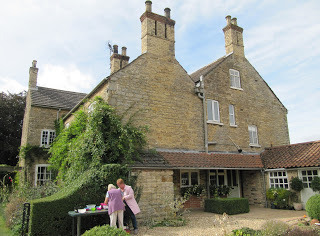
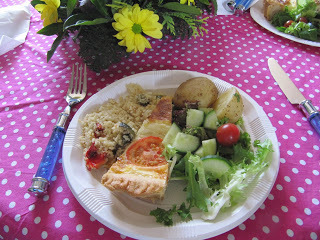 The garden is about 3 acres in size, with a big mixture of styles, both formal and informal. In the middle is a delightful, old farm house, and it was in here that I had a really excellent lunch. (The cakes mid-afternoon looked absolutely marvellous!)
The garden is about 3 acres in size, with a big mixture of styles, both formal and informal. In the middle is a delightful, old farm house, and it was in here that I had a really excellent lunch. (The cakes mid-afternoon looked absolutely marvellous!)
Then it was out into the garden, wondering which delight to explore first! When I went, on the 1st September, it was a free seed collecting day, and together with our admission ticket we were each given small envelopes for our treasured finds. And what fun people were having, and it soon became clear that people had been returning for years, and knew just what they wanted!
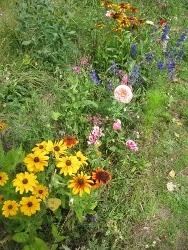 I particularly enjoyed the flower and grass meadow, where a most colourful strip had been created round the edge using both wildflowers and annuals.
I particularly enjoyed the flower and grass meadow, where a most colourful strip had been created round the edge using both wildflowers and annuals.
From there it was possible to walk to the moat, a most delightful, tranquil area which must have been a haven for wildlife, and it is clear from the web that it is favourite spot for fishermen.
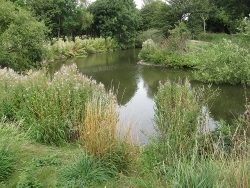
Then it was back to the garden to admire the parterre which is filled with salad crops, herbs and annuals. In high summer this must look stunning - I shall just have to come back next year!
I thoroughly enjoyed everything about my visit to Hall Farm, but most especially the friendly, informative people running the place, always for me an important factor
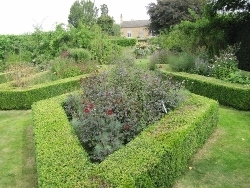
***For more about my various e-books just click here

I discovered this lovely place through the excellent National Garden Scheme (see previous blog). It is situated 7 miles east of Gainsborough on the A631

 The garden is about 3 acres in size, with a big mixture of styles, both formal and informal. In the middle is a delightful, old farm house, and it was in here that I had a really excellent lunch. (The cakes mid-afternoon looked absolutely marvellous!)
The garden is about 3 acres in size, with a big mixture of styles, both formal and informal. In the middle is a delightful, old farm house, and it was in here that I had a really excellent lunch. (The cakes mid-afternoon looked absolutely marvellous!)Then it was out into the garden, wondering which delight to explore first! When I went, on the 1st September, it was a free seed collecting day, and together with our admission ticket we were each given small envelopes for our treasured finds. And what fun people were having, and it soon became clear that people had been returning for years, and knew just what they wanted!
 I particularly enjoyed the flower and grass meadow, where a most colourful strip had been created round the edge using both wildflowers and annuals.
I particularly enjoyed the flower and grass meadow, where a most colourful strip had been created round the edge using both wildflowers and annuals.From there it was possible to walk to the moat, a most delightful, tranquil area which must have been a haven for wildlife, and it is clear from the web that it is favourite spot for fishermen.

Then it was back to the garden to admire the parterre which is filled with salad crops, herbs and annuals. In high summer this must look stunning - I shall just have to come back next year!
I thoroughly enjoyed everything about my visit to Hall Farm, but most especially the friendly, informative people running the place, always for me an important factor

***For more about my various e-books just click here

Published on September 03, 2013 02:35
August 26, 2013
Shugborough Hall - Staffordshire
http://www.aboutnottinghamshire.co.uk/
Shugborough estate is 4 miles from Stafford on the edge of Cannock Chase and covers 900 acres of beautiful countryside.
 In 1960 the Anson family gifted the estate to the National Trust in lieu of death duties, but the lovely house and other buildings are managed by Staffordshire County Council. Consequently it is quite complicated, as only part is free to NT members. (Having struggled to find the parking meter, there then was a long entrance queue, as payment varies as to which part you wish to see, and whether you are a NT member etc., so each customer took quite some time to get their tickets.)
In 1960 the Anson family gifted the estate to the National Trust in lieu of death duties, but the lovely house and other buildings are managed by Staffordshire County Council. Consequently it is quite complicated, as only part is free to NT members. (Having struggled to find the parking meter, there then was a long entrance queue, as payment varies as to which part you wish to see, and whether you are a NT member etc., so each customer took quite some time to get their tickets.)

The estate is very spread but thankfully there is an excellent free shuttle service involving both a minibus and a little train.
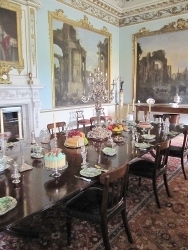
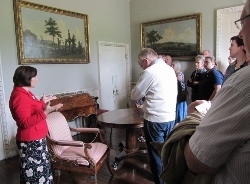 In the morning when I went there were really excellent 20 minute tours of the downstairs of the house, which I really enjoyed, as the interior is beautiful and there was just the right amount of information. Everything had been set out in such an attractive manner, for example this delightful table looked so inviting! And I quite fancied sitting in this lovely lounge, reading a book!
In the morning when I went there were really excellent 20 minute tours of the downstairs of the house, which I really enjoyed, as the interior is beautiful and there was just the right amount of information. Everything had been set out in such an attractive manner, for example this delightful table looked so inviting! And I quite fancied sitting in this lovely lounge, reading a book!
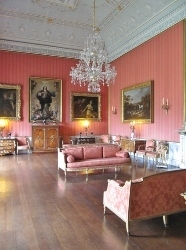
 By the side of the house is the Stable Block which houses a café, and I was pleased to be directed to a conservatory area where there were plenty of tables, whereas the main area was packed. Then it was on to visit the Servant's Quarters. So much thought and attention had been given to this quite extensive area that it would have been easy to spend the whole day exploring everything from carriages to the history of boot making in the area!
By the side of the house is the Stable Block which houses a café, and I was pleased to be directed to a conservatory area where there were plenty of tables, whereas the main area was packed. Then it was on to visit the Servant's Quarters. So much thought and attention had been given to this quite extensive area that it would have been easy to spend the whole day exploring everything from carriages to the history of boot making in the area!
Then it was time to walk outside, with the lovely formal garden then out into the wider area near the river. My only complaint was the complete lack of sign posts! I appreciate everyone is given a little map, but I found it really confusing! With few members of staff around in the grounds, it was a case of one visitor asking the next! I would also have liked noticeboards against the numerous monuments as this all got very confusing, and what was the history behind the delightful Chinese House?
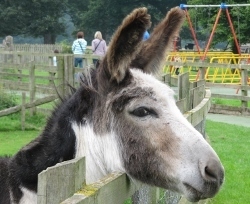 Then it was back for a return trip on the little land train before visiting the Shugborough Park Farm. I started by exploring the mill and workshops, which might have been active earlier in the day. It was nice to stop and have a cuppa and cake at the little café. Then it was out to explore the Farm and this was the only disappointment of the day. A very few animals were mostly sleeping - like a couple of very large pigs, a horse, a chicken and a flock of sheep. I was unable to see what the point of this area was supposed to be. Presumably it was aimed at children, but then information boards would have been helpful - like the names of the animals, their breed, where they came from, etc., would have made more sense.
Then it was back for a return trip on the little land train before visiting the Shugborough Park Farm. I started by exploring the mill and workshops, which might have been active earlier in the day. It was nice to stop and have a cuppa and cake at the little café. Then it was out to explore the Farm and this was the only disappointment of the day. A very few animals were mostly sleeping - like a couple of very large pigs, a horse, a chicken and a flock of sheep. I was unable to see what the point of this area was supposed to be. Presumably it was aimed at children, but then information boards would have been helpful - like the names of the animals, their breed, where they came from, etc., would have made more sense.
I was really pleased I'd made the long journey to find Shugborough Estate as it is a very special place. However, I do think some improvements, such as much better signage and easier, faster ticket buying are required. ***Are you familiar with the tragic Hardwick Love Story? If not just see my e-book


Shugborough estate is 4 miles from Stafford on the edge of Cannock Chase and covers 900 acres of beautiful countryside.
 In 1960 the Anson family gifted the estate to the National Trust in lieu of death duties, but the lovely house and other buildings are managed by Staffordshire County Council. Consequently it is quite complicated, as only part is free to NT members. (Having struggled to find the parking meter, there then was a long entrance queue, as payment varies as to which part you wish to see, and whether you are a NT member etc., so each customer took quite some time to get their tickets.)
In 1960 the Anson family gifted the estate to the National Trust in lieu of death duties, but the lovely house and other buildings are managed by Staffordshire County Council. Consequently it is quite complicated, as only part is free to NT members. (Having struggled to find the parking meter, there then was a long entrance queue, as payment varies as to which part you wish to see, and whether you are a NT member etc., so each customer took quite some time to get their tickets.)
The estate is very spread but thankfully there is an excellent free shuttle service involving both a minibus and a little train.

 In the morning when I went there were really excellent 20 minute tours of the downstairs of the house, which I really enjoyed, as the interior is beautiful and there was just the right amount of information. Everything had been set out in such an attractive manner, for example this delightful table looked so inviting! And I quite fancied sitting in this lovely lounge, reading a book!
In the morning when I went there were really excellent 20 minute tours of the downstairs of the house, which I really enjoyed, as the interior is beautiful and there was just the right amount of information. Everything had been set out in such an attractive manner, for example this delightful table looked so inviting! And I quite fancied sitting in this lovely lounge, reading a book!
 By the side of the house is the Stable Block which houses a café, and I was pleased to be directed to a conservatory area where there were plenty of tables, whereas the main area was packed. Then it was on to visit the Servant's Quarters. So much thought and attention had been given to this quite extensive area that it would have been easy to spend the whole day exploring everything from carriages to the history of boot making in the area!
By the side of the house is the Stable Block which houses a café, and I was pleased to be directed to a conservatory area where there were plenty of tables, whereas the main area was packed. Then it was on to visit the Servant's Quarters. So much thought and attention had been given to this quite extensive area that it would have been easy to spend the whole day exploring everything from carriages to the history of boot making in the area!Then it was time to walk outside, with the lovely formal garden then out into the wider area near the river. My only complaint was the complete lack of sign posts! I appreciate everyone is given a little map, but I found it really confusing! With few members of staff around in the grounds, it was a case of one visitor asking the next! I would also have liked noticeboards against the numerous monuments as this all got very confusing, and what was the history behind the delightful Chinese House?
 Then it was back for a return trip on the little land train before visiting the Shugborough Park Farm. I started by exploring the mill and workshops, which might have been active earlier in the day. It was nice to stop and have a cuppa and cake at the little café. Then it was out to explore the Farm and this was the only disappointment of the day. A very few animals were mostly sleeping - like a couple of very large pigs, a horse, a chicken and a flock of sheep. I was unable to see what the point of this area was supposed to be. Presumably it was aimed at children, but then information boards would have been helpful - like the names of the animals, their breed, where they came from, etc., would have made more sense.
Then it was back for a return trip on the little land train before visiting the Shugborough Park Farm. I started by exploring the mill and workshops, which might have been active earlier in the day. It was nice to stop and have a cuppa and cake at the little café. Then it was out to explore the Farm and this was the only disappointment of the day. A very few animals were mostly sleeping - like a couple of very large pigs, a horse, a chicken and a flock of sheep. I was unable to see what the point of this area was supposed to be. Presumably it was aimed at children, but then information boards would have been helpful - like the names of the animals, their breed, where they came from, etc., would have made more sense.I was really pleased I'd made the long journey to find Shugborough Estate as it is a very special place. However, I do think some improvements, such as much better signage and easier, faster ticket buying are required. ***Are you familiar with the tragic Hardwick Love Story? If not just see my e-book


Published on August 26, 2013 01:59
August 19, 2013
Melbourne Hall Tea Rooms - Staffordshire
http://www.aboutnottinghamshire.co.uk/
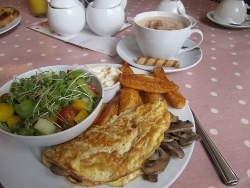 I couldn't wait to go back to this delightful venue. I've already written about visiting the Melbourne Hall Gardens in a previous blogand at that time I just called in for tea and a hot buttered crumpet - and very nice it was too! This time I had a mushroom omelette, and very substantial meal it turned out!
I couldn't wait to go back to this delightful venue. I've already written about visiting the Melbourne Hall Gardens in a previous blogand at that time I just called in for tea and a hot buttered crumpet - and very nice it was too! This time I had a mushroom omelette, and very substantial meal it turned out!
Then I discovered that the back of the menu was full of the most interesting information - I just love it when that happens! This is what it says:
The Melbourne Hall Tea Rooms were built in 1708 as part of Thomas Coke's grand plan for modernising Melbourne Hall. ..The building was originally described as 'A Wash House and Bake House with laundry over'....In 1903 the building was gutted by a fire. It was rebuilt with a new roof and first floor boarding and the downstairs made into the single room you see today. During the Second World War, Polish airmen were billeted upstairs and later, a family whose home had been bombed, was housed in the downstairs area. Since then the building has been used as a Chapel for the Hall, a Girl Guides Meeting place and eventually a Tea Rooms.'
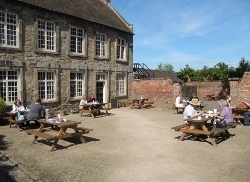 One thing I always like when I eat out is home-made food, with the ingredients sourced locally, and that is certainly the case here. As the back of the menu explains..
One thing I always like when I eat out is home-made food, with the ingredients sourced locally, and that is certainly the case here. As the back of the menu explains..
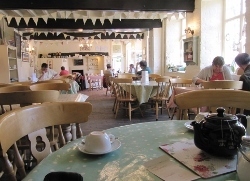 Please be assured that everything possible is homemade by us and always will be. The one thing that we do not have the time or skills to bake is bread, however this is locally baked in Ashby de la Zouch and delivered to us daily.'
Please be assured that everything possible is homemade by us and always will be. The one thing that we do not have the time or skills to bake is bread, however this is locally baked in Ashby de la Zouch and delivered to us daily.'
However, this was the bit I really loved...
Our milk is also local, from Mount St Bernard Abbey in Oaks in Charnwood which is the only remaining Cistercian Monastery in England, the monks here live by the Rule of St Benedict and dairy farming has been at the heart of Monastic life for centuries. We collect our milk twice a week on their pasteurising days. It's trip that we really enjoy as it's a lovely drive up there through some beautiful countryside and a really peaceful place to go. It also ensures that our milk is as fresh as it can be.'
Now who could possibly resist a visit to such a delightful establishment?***Did you know there was oil under Sherwood Forest that made a real difference during World War Two? To see my e-book about it just click here

 I couldn't wait to go back to this delightful venue. I've already written about visiting the Melbourne Hall Gardens in a previous blogand at that time I just called in for tea and a hot buttered crumpet - and very nice it was too! This time I had a mushroom omelette, and very substantial meal it turned out!
I couldn't wait to go back to this delightful venue. I've already written about visiting the Melbourne Hall Gardens in a previous blogand at that time I just called in for tea and a hot buttered crumpet - and very nice it was too! This time I had a mushroom omelette, and very substantial meal it turned out!Then I discovered that the back of the menu was full of the most interesting information - I just love it when that happens! This is what it says:
The Melbourne Hall Tea Rooms were built in 1708 as part of Thomas Coke's grand plan for modernising Melbourne Hall. ..The building was originally described as 'A Wash House and Bake House with laundry over'....In 1903 the building was gutted by a fire. It was rebuilt with a new roof and first floor boarding and the downstairs made into the single room you see today. During the Second World War, Polish airmen were billeted upstairs and later, a family whose home had been bombed, was housed in the downstairs area. Since then the building has been used as a Chapel for the Hall, a Girl Guides Meeting place and eventually a Tea Rooms.'
 One thing I always like when I eat out is home-made food, with the ingredients sourced locally, and that is certainly the case here. As the back of the menu explains..
One thing I always like when I eat out is home-made food, with the ingredients sourced locally, and that is certainly the case here. As the back of the menu explains.. Please be assured that everything possible is homemade by us and always will be. The one thing that we do not have the time or skills to bake is bread, however this is locally baked in Ashby de la Zouch and delivered to us daily.'
Please be assured that everything possible is homemade by us and always will be. The one thing that we do not have the time or skills to bake is bread, however this is locally baked in Ashby de la Zouch and delivered to us daily.'However, this was the bit I really loved...
Our milk is also local, from Mount St Bernard Abbey in Oaks in Charnwood which is the only remaining Cistercian Monastery in England, the monks here live by the Rule of St Benedict and dairy farming has been at the heart of Monastic life for centuries. We collect our milk twice a week on their pasteurising days. It's trip that we really enjoy as it's a lovely drive up there through some beautiful countryside and a really peaceful place to go. It also ensures that our milk is as fresh as it can be.'
Now who could possibly resist a visit to such a delightful establishment?***Did you know there was oil under Sherwood Forest that made a real difference during World War Two? To see my e-book about it just click here

Published on August 19, 2013 07:54
August 12, 2013
Horses at Bolsover Castle - Nottinghamshire
http://www.aboutnottinghamshire.co.uk/
 For hundreds of years the Riding School has been unused - but no more! English Heritage has restored the sand floor of this impressive building so that it looks very much like the original 17th century surface, and similar to the floors at the acclaimed Spanish Riding School located in Vienna. In addition a tier of benches, seating around 120 people, has been erected at the end of the space, and the firm Action Horses are supplying the entertainment.
For hundreds of years the Riding School has been unused - but no more! English Heritage has restored the sand floor of this impressive building so that it looks very much like the original 17th century surface, and similar to the floors at the acclaimed Spanish Riding School located in Vienna. In addition a tier of benches, seating around 120 people, has been erected at the end of the space, and the firm Action Horses are supplying the entertainment.
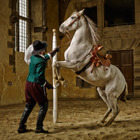 William Cavendish, the owner of this delightful place, was absolutely passionate, and very knowledgeable about horses. He built this magnificent riding house in the 1630s so that he could exercise and train his beloved horses. It is now the only substantially intact building of its kind left in the country.
William Cavendish, the owner of this delightful place, was absolutely passionate, and very knowledgeable about horses. He built this magnificent riding house in the 1630s so that he could exercise and train his beloved horses. It is now the only substantially intact building of its kind left in the country.
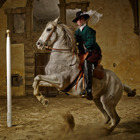 The 20 minute shows are included in the price of admission, but the crowds are enormous for this totally unique event. Shows are at 11 o'clock, 1 and 3 o'clock, but I found that all tickets had gone by mid-morning, leaving many people disappointed. Unfortunately horses will only be at Bolsover until the end of August, and not over the Bank Holiday when Jousting is the special event.
The 20 minute shows are included in the price of admission, but the crowds are enormous for this totally unique event. Shows are at 11 o'clock, 1 and 3 o'clock, but I found that all tickets had gone by mid-morning, leaving many people disappointed. Unfortunately horses will only be at Bolsover until the end of August, and not over the Bank Holiday when Jousting is the special event.
I really enjoyed this event, even though I would have liked it longer! However, it was good to be able to get up close to the friendly horses afterwards, and to chat to the very skilled riders. I was hugely disappointed that absolutely no photography was allowed, apparently a ruling by English Heritage. (All the photos in this blog have come from various web sites.)
However there are plans for this hugely popular event to return next year perhaps in a slightly different format, and using two companies on alternate weekends - certainly something to look forward to.

***'Secrets' my story of an 11-year old boy caught up in the French Resistance. Will he survive? To find out more just click here

 For hundreds of years the Riding School has been unused - but no more! English Heritage has restored the sand floor of this impressive building so that it looks very much like the original 17th century surface, and similar to the floors at the acclaimed Spanish Riding School located in Vienna. In addition a tier of benches, seating around 120 people, has been erected at the end of the space, and the firm Action Horses are supplying the entertainment.
For hundreds of years the Riding School has been unused - but no more! English Heritage has restored the sand floor of this impressive building so that it looks very much like the original 17th century surface, and similar to the floors at the acclaimed Spanish Riding School located in Vienna. In addition a tier of benches, seating around 120 people, has been erected at the end of the space, and the firm Action Horses are supplying the entertainment. William Cavendish, the owner of this delightful place, was absolutely passionate, and very knowledgeable about horses. He built this magnificent riding house in the 1630s so that he could exercise and train his beloved horses. It is now the only substantially intact building of its kind left in the country.
William Cavendish, the owner of this delightful place, was absolutely passionate, and very knowledgeable about horses. He built this magnificent riding house in the 1630s so that he could exercise and train his beloved horses. It is now the only substantially intact building of its kind left in the country.  The 20 minute shows are included in the price of admission, but the crowds are enormous for this totally unique event. Shows are at 11 o'clock, 1 and 3 o'clock, but I found that all tickets had gone by mid-morning, leaving many people disappointed. Unfortunately horses will only be at Bolsover until the end of August, and not over the Bank Holiday when Jousting is the special event.
The 20 minute shows are included in the price of admission, but the crowds are enormous for this totally unique event. Shows are at 11 o'clock, 1 and 3 o'clock, but I found that all tickets had gone by mid-morning, leaving many people disappointed. Unfortunately horses will only be at Bolsover until the end of August, and not over the Bank Holiday when Jousting is the special event.I really enjoyed this event, even though I would have liked it longer! However, it was good to be able to get up close to the friendly horses afterwards, and to chat to the very skilled riders. I was hugely disappointed that absolutely no photography was allowed, apparently a ruling by English Heritage. (All the photos in this blog have come from various web sites.)
However there are plans for this hugely popular event to return next year perhaps in a slightly different format, and using two companies on alternate weekends - certainly something to look forward to.

***'Secrets' my story of an 11-year old boy caught up in the French Resistance. Will he survive? To find out more just click here

Published on August 12, 2013 06:58
August 6, 2013
Sculpture in the Sanctuary 2013 - Southwell - Nottinghamshire
http://www.aboutnottinghamshire.co.uk/
Hooray! It's that time of the year again! I just love sculptures, particularly those situated in the landscape, and here at Reg Taylor's Garden Centre the swan sanctuary is just lovely at any time.
This year (the 3rd annual event - click here for previous blog) metal sculpture were much in evidence. I must admit this is not my favourite medium, but I could appreciate the amount of work and skill that must have been involved.
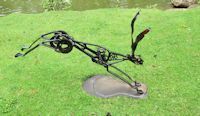 This is 'hare' by David Sharpe, priced at £375.
This is 'hare' by David Sharpe, priced at £375.
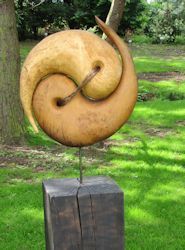 One that rather appealed to me was 'Equal & Opposite' created by Lorraine Botterill and selling for £1,900.
One that rather appealed to me was 'Equal & Opposite' created by Lorraine Botterill and selling for £1,900.
And who could not fall in love with this delightful pair skilfully made of willow?
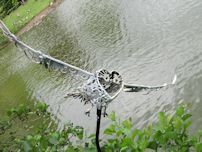 There were probably more than a hundred different sculptures - certainly something for everyone, and it was surprising how long it took to stroll round admiring the works not only in the lovely sanctuary but in one of the Glasshouses too.
There were probably more than a hundred different sculptures - certainly something for everyone, and it was surprising how long it took to stroll round admiring the works not only in the lovely sanctuary but in one of the Glasshouses too.
And for a souvenir of my enjoyable visit what could be lovelier than a little porcelain peace dove created by Soo Durham. The accompanying information sheet read:
"Soo's Syrian Tree
Since the very beginning of the Syrian conflict I have been touched by the plight of the Syrian children. In the face of the escalating crisis my sadness and despair for the children has deepened. I now feel compelled to actively highlight their suffering.
I have therefor decided to create a Syrian tree from which I hope to raise money to donate to the Unicef Syrian Children's Crisis Appeal for which I am a registered fun raiser. ALL proceeds from the peace doves will be donated to the cause.
The doves are made of porcelain and are therefore weatherproof. They look lovely hanging in a tree, dancing in the wind...
Not only will you be donating to a worthy cause you also get to take home a peace dove!
Soo's web page where the final amount raised will be posted is www.barechic.com
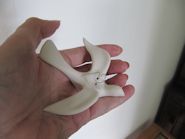 The sculpture exhibition continues until the 8th September 2013.
The sculpture exhibition continues until the 8th September 2013.
*** Are you familiar with my e-book The Hardwick Love Story?

Hooray! It's that time of the year again! I just love sculptures, particularly those situated in the landscape, and here at Reg Taylor's Garden Centre the swan sanctuary is just lovely at any time.
This year (the 3rd annual event - click here for previous blog) metal sculpture were much in evidence. I must admit this is not my favourite medium, but I could appreciate the amount of work and skill that must have been involved.
 This is 'hare' by David Sharpe, priced at £375.
This is 'hare' by David Sharpe, priced at £375. One that rather appealed to me was 'Equal & Opposite' created by Lorraine Botterill and selling for £1,900.
One that rather appealed to me was 'Equal & Opposite' created by Lorraine Botterill and selling for £1,900.And who could not fall in love with this delightful pair skilfully made of willow?

 There were probably more than a hundred different sculptures - certainly something for everyone, and it was surprising how long it took to stroll round admiring the works not only in the lovely sanctuary but in one of the Glasshouses too.
There were probably more than a hundred different sculptures - certainly something for everyone, and it was surprising how long it took to stroll round admiring the works not only in the lovely sanctuary but in one of the Glasshouses too.And for a souvenir of my enjoyable visit what could be lovelier than a little porcelain peace dove created by Soo Durham. The accompanying information sheet read:
"Soo's Syrian Tree
Since the very beginning of the Syrian conflict I have been touched by the plight of the Syrian children. In the face of the escalating crisis my sadness and despair for the children has deepened. I now feel compelled to actively highlight their suffering.
I have therefor decided to create a Syrian tree from which I hope to raise money to donate to the Unicef Syrian Children's Crisis Appeal for which I am a registered fun raiser. ALL proceeds from the peace doves will be donated to the cause.
The doves are made of porcelain and are therefore weatherproof. They look lovely hanging in a tree, dancing in the wind...
Not only will you be donating to a worthy cause you also get to take home a peace dove!
Soo's web page where the final amount raised will be posted is www.barechic.com
 The sculpture exhibition continues until the 8th September 2013.
The sculpture exhibition continues until the 8th September 2013. *** Are you familiar with my e-book The Hardwick Love Story?

Published on August 06, 2013 23:20
August 5, 2013
Joseph Banks Tribute Garden - Horncastle - Lincolnshire
http://www.aboutnottinghamshire.co.uk/
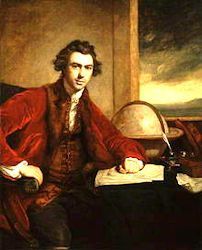 Banks divided his time between Lincolnshire and London. When he was 21 he inherited the impressive estate of Revesby Abbey and become both the local squire and a magistrate in Horncastle. He had a burning interest in science and became an adviser to King George III, urging the monarch to support voyages of discovery to new lands.
Banks divided his time between Lincolnshire and London. When he was 21 he inherited the impressive estate of Revesby Abbey and become both the local squire and a magistrate in Horncastle. He had a burning interest in science and became an adviser to King George III, urging the monarch to support voyages of discovery to new lands.
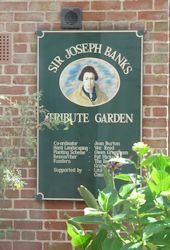 His first such expedition took him to Newfoundland and Labrador, where amongst his many recordings he documented 34 species of birds. From this success he was appointed to the first of James Cook's voyages that lasted from 1768 til 1771. He made scientific descriptions of the botany he saw in the south Pacific Ocean on board the Endeavour. Whilst working on his great work Florilegium and was elected President of the Royal Society in 1778, a position he was to hold for over 41 years.
His first such expedition took him to Newfoundland and Labrador, where amongst his many recordings he documented 34 species of birds. From this success he was appointed to the first of James Cook's voyages that lasted from 1768 til 1771. He made scientific descriptions of the botany he saw in the south Pacific Ocean on board the Endeavour. Whilst working on his great work Florilegium and was elected President of the Royal Society in 1778, a position he was to hold for over 41 years.
In Horncastle the Sir Joseph Banks Centre is in a Grade II listed building which has recently been restored by the Heritage Trust of Lincolnshire to celebrate his life.
The garden is a small, enclosed courtyard, tucked behind a fascinating gift shop well stocked with delights from the very best local craftspeople.
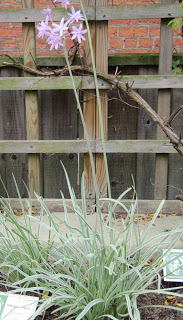 I was delighted to be able to buy a plant that I'd seen growing in the well-labelled little garden - a Tulbaghia Violacea 'Silver Lace' - which will remind me of my interesting visit to this unexpected treasure.
I was delighted to be able to buy a plant that I'd seen growing in the well-labelled little garden - a Tulbaghia Violacea 'Silver Lace' - which will remind me of my interesting visit to this unexpected treasure.
****
Are you familiar with The Clumber Love Story? For my e-book just click here

 Banks divided his time between Lincolnshire and London. When he was 21 he inherited the impressive estate of Revesby Abbey and become both the local squire and a magistrate in Horncastle. He had a burning interest in science and became an adviser to King George III, urging the monarch to support voyages of discovery to new lands.
Banks divided his time between Lincolnshire and London. When he was 21 he inherited the impressive estate of Revesby Abbey and become both the local squire and a magistrate in Horncastle. He had a burning interest in science and became an adviser to King George III, urging the monarch to support voyages of discovery to new lands. His first such expedition took him to Newfoundland and Labrador, where amongst his many recordings he documented 34 species of birds. From this success he was appointed to the first of James Cook's voyages that lasted from 1768 til 1771. He made scientific descriptions of the botany he saw in the south Pacific Ocean on board the Endeavour. Whilst working on his great work Florilegium and was elected President of the Royal Society in 1778, a position he was to hold for over 41 years.
His first such expedition took him to Newfoundland and Labrador, where amongst his many recordings he documented 34 species of birds. From this success he was appointed to the first of James Cook's voyages that lasted from 1768 til 1771. He made scientific descriptions of the botany he saw in the south Pacific Ocean on board the Endeavour. Whilst working on his great work Florilegium and was elected President of the Royal Society in 1778, a position he was to hold for over 41 years. In Horncastle the Sir Joseph Banks Centre is in a Grade II listed building which has recently been restored by the Heritage Trust of Lincolnshire to celebrate his life.
The garden is a small, enclosed courtyard, tucked behind a fascinating gift shop well stocked with delights from the very best local craftspeople.
 I was delighted to be able to buy a plant that I'd seen growing in the well-labelled little garden - a Tulbaghia Violacea 'Silver Lace' - which will remind me of my interesting visit to this unexpected treasure.
I was delighted to be able to buy a plant that I'd seen growing in the well-labelled little garden - a Tulbaghia Violacea 'Silver Lace' - which will remind me of my interesting visit to this unexpected treasure. ****
Are you familiar with The Clumber Love Story? For my e-book just click here

Published on August 05, 2013 05:43
July 27, 2013
Tatton Park Flower Show - Knutsford - Cheshire
http://www.aboutnottinghamshire.co.uk/
The first Royal Horticultural Society Show was held on this impressive site in 1999. Apart from some thousand beautiful acres of deer park, there 50 acres of landscaped gardens as well as an impressive Mansion.
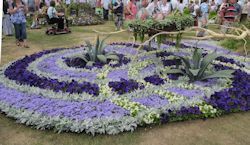 However, it was the Garden Show that I'd come to enjoy. It was very crowded when I first arrived, but gradually as the day progressed it became quieter and more enjoyable. I always particularly like the outdoor exhibits and this one, entitled 'The Ripple Effect' was submitted by Manchester City Council & Mary & Joseph House. The flower bed depicts the work of The House in supporting mental health recovery through art and horticultural therapy. The yearlong process of working on the flower bed's concept, design and construction created a 'ripple effect' of success for all participating residents and their support network.
However, it was the Garden Show that I'd come to enjoy. It was very crowded when I first arrived, but gradually as the day progressed it became quieter and more enjoyable. I always particularly like the outdoor exhibits and this one, entitled 'The Ripple Effect' was submitted by Manchester City Council & Mary & Joseph House. The flower bed depicts the work of The House in supporting mental health recovery through art and horticultural therapy. The yearlong process of working on the flower bed's concept, design and construction created a 'ripple effect' of success for all participating residents and their support network.
 In the show gardens it was impossible not to be impressed by 'A Stainless Century' which celebrated the invention of stainless steel and the impact it had on the city of Sheffield and the wider world. The central water feature represents the flow of molten metal, and the steel sculptural arches depict the curved roof of the lovely Winter Garden (see previous blog)
In the show gardens it was impossible not to be impressed by 'A Stainless Century' which celebrated the invention of stainless steel and the impact it had on the city of Sheffield and the wider world. The central water feature represents the flow of molten metal, and the steel sculptural arches depict the curved roof of the lovely Winter Garden (see previous blog)
As expected, the exhibits within the numerous marquees were quite breath-taking. How much skill and time it must have taken to arrange all these veggies to such perfection.


And of course there are other things to do as well as admire all the plants. I watch a flower arranging demo, always one of my favourite pastimes, as well as enjoying a chef at work.
Now I just have to wait another year to do it all over again!
*** To learn more about me and my books just click here

The first Royal Horticultural Society Show was held on this impressive site in 1999. Apart from some thousand beautiful acres of deer park, there 50 acres of landscaped gardens as well as an impressive Mansion.
 However, it was the Garden Show that I'd come to enjoy. It was very crowded when I first arrived, but gradually as the day progressed it became quieter and more enjoyable. I always particularly like the outdoor exhibits and this one, entitled 'The Ripple Effect' was submitted by Manchester City Council & Mary & Joseph House. The flower bed depicts the work of The House in supporting mental health recovery through art and horticultural therapy. The yearlong process of working on the flower bed's concept, design and construction created a 'ripple effect' of success for all participating residents and their support network.
However, it was the Garden Show that I'd come to enjoy. It was very crowded when I first arrived, but gradually as the day progressed it became quieter and more enjoyable. I always particularly like the outdoor exhibits and this one, entitled 'The Ripple Effect' was submitted by Manchester City Council & Mary & Joseph House. The flower bed depicts the work of The House in supporting mental health recovery through art and horticultural therapy. The yearlong process of working on the flower bed's concept, design and construction created a 'ripple effect' of success for all participating residents and their support network.  In the show gardens it was impossible not to be impressed by 'A Stainless Century' which celebrated the invention of stainless steel and the impact it had on the city of Sheffield and the wider world. The central water feature represents the flow of molten metal, and the steel sculptural arches depict the curved roof of the lovely Winter Garden (see previous blog)
In the show gardens it was impossible not to be impressed by 'A Stainless Century' which celebrated the invention of stainless steel and the impact it had on the city of Sheffield and the wider world. The central water feature represents the flow of molten metal, and the steel sculptural arches depict the curved roof of the lovely Winter Garden (see previous blog) As expected, the exhibits within the numerous marquees were quite breath-taking. How much skill and time it must have taken to arrange all these veggies to such perfection.


And of course there are other things to do as well as admire all the plants. I watch a flower arranging demo, always one of my favourite pastimes, as well as enjoying a chef at work.
Now I just have to wait another year to do it all over again!
*** To learn more about me and my books just click here

Published on July 27, 2013 09:23
July 22, 2013
Clumber Cafe - Clumber Park - N. Nottinghamshire
http://www.aboutnottinghamshire.co.uk/
I love this National Trust property - see
 The first thing that struck me was the excellent lay-out. Not only was the food well displayed but there was plenty of space. Then there was the eating areas, with so much to chose from, so there was somewhere
The first thing that struck me was the excellent lay-out. Not only was the food well displayed but there was plenty of space. Then there was the eating areas, with so much to chose from, so there was somewhere
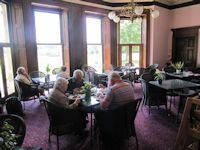 for everyone. This is the main area, but my favourite is beyond that into a really lovely room known as The Duke's Study, all that remains of a once palatial home. Here there are views over the lawns to the lake - just so restful and relaxing.
for everyone. This is the main area, but my favourite is beyond that into a really lovely room known as The Duke's Study, all that remains of a once palatial home. Here there are views over the lawns to the lake - just so restful and relaxing.
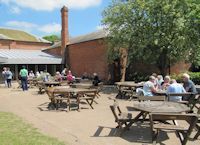 People with dogs are also catered for with a large eating area outside.
People with dogs are also catered for with a large eating area outside.
The food is locally source, which is something I really like. I had locally-made sausage and mash, which was certainly tasty, but I could have had local lamb and mint pie with veggies, or tomato and basil pasta bake topped with cheddar cheese and homemade garlic bread.
On the way out I spotted these Ploughman's lunches which I thought looked really tasty - certainly something to look forward to next visit!

*** To see all my books just click here

I love this National Trust property - see
 The first thing that struck me was the excellent lay-out. Not only was the food well displayed but there was plenty of space. Then there was the eating areas, with so much to chose from, so there was somewhere
The first thing that struck me was the excellent lay-out. Not only was the food well displayed but there was plenty of space. Then there was the eating areas, with so much to chose from, so there was somewhere  for everyone. This is the main area, but my favourite is beyond that into a really lovely room known as The Duke's Study, all that remains of a once palatial home. Here there are views over the lawns to the lake - just so restful and relaxing.
for everyone. This is the main area, but my favourite is beyond that into a really lovely room known as The Duke's Study, all that remains of a once palatial home. Here there are views over the lawns to the lake - just so restful and relaxing. People with dogs are also catered for with a large eating area outside.
People with dogs are also catered for with a large eating area outside.The food is locally source, which is something I really like. I had locally-made sausage and mash, which was certainly tasty, but I could have had local lamb and mint pie with veggies, or tomato and basil pasta bake topped with cheddar cheese and homemade garlic bread.
On the way out I spotted these Ploughman's lunches which I thought looked really tasty - certainly something to look forward to next visit!

*** To see all my books just click here

Published on July 22, 2013 03:31
July 18, 2013
Barrow Hill Roundhouse Railway Centre - Staveley - Chesterfield - Derbyshitre
http://www.aboutnottinghamshire.co.uk/
 Barrow Hill Roundhouse is not far from Chesterfield in Derbyshire and close to junctions 29a of the M1. It is a unique example of 19th century railway architecture, and was built originally to house the freight locomotives which served the Staveley Coal and Iron Works.
Barrow Hill Roundhouse is not far from Chesterfield in Derbyshire and close to junctions 29a of the M1. It is a unique example of 19th century railway architecture, and was built originally to house the freight locomotives which served the Staveley Coal and Iron Works.
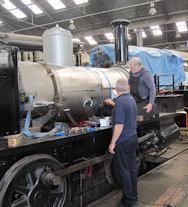 In it's heyday more than 200 enginemen worked each day to take coal to the industrial centres of Derbyshire and beyond. With the closure of the local pits this important site nearly was demolished, but fortunately in 1989 the Barrow Hill Engine Shed Society was formed. This dedicated group of skilled volunteers finally bought the redundant buildings and railway yards from British Rail in 1996.
In it's heyday more than 200 enginemen worked each day to take coal to the industrial centres of Derbyshire and beyond. With the closure of the local pits this important site nearly was demolished, but fortunately in 1989 the Barrow Hill Engine Shed Society was formed. This dedicated group of skilled volunteers finally bought the redundant buildings and railway yards from British Rail in 1996.
The shed is now full to overflowing with restored engines, there's a frequently running train up to the Springwell branch, and in 2003 the Deltic Preservation Society made Barrow Hill its home, building its own maintenance depot and museum adjacent to the Roundhouse.
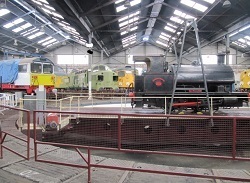
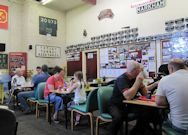 Of course there's also an excellent buffet serving a surprising wide range of fry-ups etc. (I had a very tasty sausage roll with, of course, chips! Yummy!)
Of course there's also an excellent buffet serving a surprising wide range of fry-ups etc. (I had a very tasty sausage roll with, of course, chips! Yummy!)
However, the highlight for me was watching the original turntable in action - quite amazing.
***For more about me and my books just click here
 Barrow Hill Roundhouse is not far from Chesterfield in Derbyshire and close to junctions 29a of the M1. It is a unique example of 19th century railway architecture, and was built originally to house the freight locomotives which served the Staveley Coal and Iron Works.
Barrow Hill Roundhouse is not far from Chesterfield in Derbyshire and close to junctions 29a of the M1. It is a unique example of 19th century railway architecture, and was built originally to house the freight locomotives which served the Staveley Coal and Iron Works. In it's heyday more than 200 enginemen worked each day to take coal to the industrial centres of Derbyshire and beyond. With the closure of the local pits this important site nearly was demolished, but fortunately in 1989 the Barrow Hill Engine Shed Society was formed. This dedicated group of skilled volunteers finally bought the redundant buildings and railway yards from British Rail in 1996.
In it's heyday more than 200 enginemen worked each day to take coal to the industrial centres of Derbyshire and beyond. With the closure of the local pits this important site nearly was demolished, but fortunately in 1989 the Barrow Hill Engine Shed Society was formed. This dedicated group of skilled volunteers finally bought the redundant buildings and railway yards from British Rail in 1996.The shed is now full to overflowing with restored engines, there's a frequently running train up to the Springwell branch, and in 2003 the Deltic Preservation Society made Barrow Hill its home, building its own maintenance depot and museum adjacent to the Roundhouse.

 Of course there's also an excellent buffet serving a surprising wide range of fry-ups etc. (I had a very tasty sausage roll with, of course, chips! Yummy!)
Of course there's also an excellent buffet serving a surprising wide range of fry-ups etc. (I had a very tasty sausage roll with, of course, chips! Yummy!)However, the highlight for me was watching the original turntable in action - quite amazing.
***For more about me and my books just click here

Published on July 18, 2013 12:10
July 11, 2013
Queen Mother Memorial - The Mall - London
http://www.aboutnottinghamshire.co.uk/
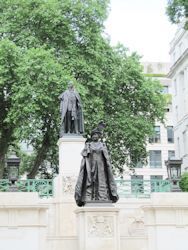 It was the crowds that attracted me. Every tour guide led his party to this spot. What was going on? I just had to go over and have a look.
It was the crowds that attracted me. Every tour guide led his party to this spot. What was going on? I just had to go over and have a look.
It turned out to the memorial to the Queen's parents. At the top is a typical statue of King George VI and below is a formal image of his wife, aged 51, the year she was widowed. She is wearing the Order of the Garter Robes.
 However, by far the most interesting are the two bronze reliefs situated below on either side. One shows the King and Queen on a walkabout during the Second World War. They had been urged to leave the country and move somewhere safer, but they refused. When Buckingham Palace was bombed in 1940 she is reported to have said "I'm glad we have been bombed. Now I can look the East End in the face."
However, by far the most interesting are the two bronze reliefs situated below on either side. One shows the King and Queen on a walkabout during the Second World War. They had been urged to leave the country and move somewhere safer, but they refused. When Buckingham Palace was bombed in 1940 she is reported to have said "I'm glad we have been bombed. Now I can look the East End in the face."
On the other side she is being applauded by the crowds at Royal Ascot as a winning jockey kisses her hand. She was a passionate race goer, and very knowledgeable, like the present Queen, and won a total of 445 winners over the years, making her one of the most successful owners ever.
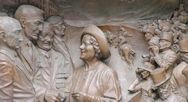
 It also shows her in the garden of her beloved Castle of Mey in Caithness, Scotland with of course her beloved corgis.
It also shows her in the garden of her beloved Castle of Mey in Caithness, Scotland with of course her beloved corgis.
Altogether I thought this a delightful and much more interesting memorial than an ordinary statue and was pleased
 to have found it, especially as the following day was the Trooping of the Colour, and the Queen would be driving down The Mall, passed this very spot, and probably glanced over at this fitting tribute to her parents.
to have found it, especially as the following day was the Trooping of the Colour, and the Queen would be driving down The Mall, passed this very spot, and probably glanced over at this fitting tribute to her parents.
*** For information about my ebooks just click here

 It was the crowds that attracted me. Every tour guide led his party to this spot. What was going on? I just had to go over and have a look.
It was the crowds that attracted me. Every tour guide led his party to this spot. What was going on? I just had to go over and have a look.It turned out to the memorial to the Queen's parents. At the top is a typical statue of King George VI and below is a formal image of his wife, aged 51, the year she was widowed. She is wearing the Order of the Garter Robes.
 However, by far the most interesting are the two bronze reliefs situated below on either side. One shows the King and Queen on a walkabout during the Second World War. They had been urged to leave the country and move somewhere safer, but they refused. When Buckingham Palace was bombed in 1940 she is reported to have said "I'm glad we have been bombed. Now I can look the East End in the face."
However, by far the most interesting are the two bronze reliefs situated below on either side. One shows the King and Queen on a walkabout during the Second World War. They had been urged to leave the country and move somewhere safer, but they refused. When Buckingham Palace was bombed in 1940 she is reported to have said "I'm glad we have been bombed. Now I can look the East End in the face."On the other side she is being applauded by the crowds at Royal Ascot as a winning jockey kisses her hand. She was a passionate race goer, and very knowledgeable, like the present Queen, and won a total of 445 winners over the years, making her one of the most successful owners ever.

 It also shows her in the garden of her beloved Castle of Mey in Caithness, Scotland with of course her beloved corgis.
It also shows her in the garden of her beloved Castle of Mey in Caithness, Scotland with of course her beloved corgis.Altogether I thought this a delightful and much more interesting memorial than an ordinary statue and was pleased
 to have found it, especially as the following day was the Trooping of the Colour, and the Queen would be driving down The Mall, passed this very spot, and probably glanced over at this fitting tribute to her parents.
to have found it, especially as the following day was the Trooping of the Colour, and the Queen would be driving down The Mall, passed this very spot, and probably glanced over at this fitting tribute to her parents. *** For information about my ebooks just click here

Published on July 11, 2013 02:52



